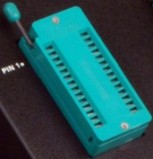Zero Insertion Force Sockets, ZIF
Intel Pentium III Socket ZIF Socket-370 |
Two PC cpu |
AMD Athlon Socket ZIF Socket-A |
A Zero Insertion Force Socket [ZIF] is a socket that requires no force to install an IC into the socket. A spring actuated level [left side of pictures] is used to clamp the device in place once it has been installed. The lever clamps the pins in place and not necessarily the IC to the socket. Once the lever is closed the pins of the IC make contact with the pins of the socket.
By definition a ZIF socket accepts a through-hole IC, one with pins [not a surface mount device]. However the ZIF socket may be mounted on a board either as a Pin Grid Array [through hole], or Ball Grid Array [surface mount]. No insertion force would be required to place a surface mount part onto a socket, however the part might be clamped into place.
Commercial ZIF uses: The ZIF sockets shown above are designed for a particular cpu and do not allow other processors to use the socket. The cpu ZIF sockets are processor specific by one or more of three different determinations;
The number of pins they accept, match the number of pins on the processor chip.
The pin grid, or pin arrangement the processor uses, which changes for different processors.
Missing pins, not used by the processor, which are then blocked or filled-in on the socket.
PC ZIF sockets normally change with each new cpu entering the market, but do not necessarily change with variations within a processor family [as in different speed grades].
In addition to ZIF sockets being used with processors mounted on personal computer mother boards, the sockets are also used with EPROM programming devices so the components can be easily inserted and removed with out soldiering. Most ICs these days are surface mount devices for a number of reasons, but PC processors are still through hole Pin Grid Array [PGA] devices for easy up-grade.
Industrial ZIF Uses: ZIF sockets are also used on programmable logic equipment, or programmers. So programmable logic ICs, such as PLDs, PROMs or EPROMs may be inserted into a ZIF socket, programmed, and than removed and installed on a printed wiring board. The picture to the upper left shows a ZIF socket used on a programmer. Note that the socket shown will accept any package, in that width, with any number of pins up to the maximum the socket will accept, which is 28 pins. Normally the programmer will hold some number of IC sockets which cover the common package widths used with ICs, and sometimes a number of sockets of the same size for gang-programming a number of ICs at once.
Also refer to cpu Socket Types used on PC Motherboards [many more than the two shown], which also details the number of different types of processor styles.










